When approaching the use of piano pedals, you’ll first want to make sure that your seating arrangement allows for easy and comfortable access to them.
Sitting too far or too close can hinder your ability to operate the pedals effectively. Familiarizing yourself with the distinct functions of each pedal—the sustain, soft, and sostenuto—can greatly enhance your sound control and expressive range.
But how do you avoid common pitfalls like over-pedaling or mistimed releases? Understanding these nuances can elevate your playing, making it more polished and professional. So, what are the key techniques to mastering piano?
TL-DR
- Press the sustain pedal to lift dampers and sustain notes for a smoother, connected sound.
- Use the soft pedal to shift hammers and produce a quieter, more mellow tone.
- Apply the sostenuto pedal to sustain specific notes while playing additional ones without sustain.
- Practice half pedaling to create subtle sustain effects suitable for delicate musical passages.
- Follow pedal markings in the music score to ensure accurate dynamics and phrasing.
Adjusting Your Seat

To use piano pedals effectively, start by adjusting your seat height so your feet comfortably reach the pedals. Sit close enough to the piano to allow your legs to operate the pedals with ease. Finding the right seat height is essential for maintaining a balanced posture. If your seat is too high or too low, you’ll strain your legs and back, which can affect your performance.
Ensure your seat is stable and secure. A wobbly seat can disrupt your foot movements and make it difficult to control the pedals accurately. Seat stability is vital for smooth changes and maintaining a consistent sound.
Experiment with different seat heights to find the most comfortable position. Your feet should rest naturally on the pedals without stretching or feeling cramped. Adjusting your seat height might take a few tries, but it’s worth the effort to achieve excellent control over the piano pedals.
Understanding Pedal Types
Once you’ve adjusted your seat, it’s important to understand the different types of piano pedals and their functions. Piano pedals greatly influence the sound and expression of your playing.
There are three main pedals you’ll encounter:
- Sustain Pedal (Damper Pedal): Located on the right, this is the most commonly used pedal. When you press it, the dampers lift off the strings, allowing them to vibrate freely and sustain the notes longer. This pedal is essential for creating a rich, resonant sound.
- Soft Pedal (Una Corda Pedal): Found on the left, the soft pedal or una corda pedal shifts the piano’s mechanism so the hammers strike fewer strings. This results in a softer, more muted sound. It’s perfect for delicate passages and nuanced expressions.
- Sostenuto Pedal: Positioned in the middle, the sostenuto pedal holds only the notes you’re playing at the moment you press it, while allowing subsequent notes to be played without sustain. This selective sustain is useful for pieces that require certain notes to be held while others are played normally.
Understanding these piano pedals and their specific pedal usage will enhance your playing technique and broaden your musical expression.
Sustain Pedal
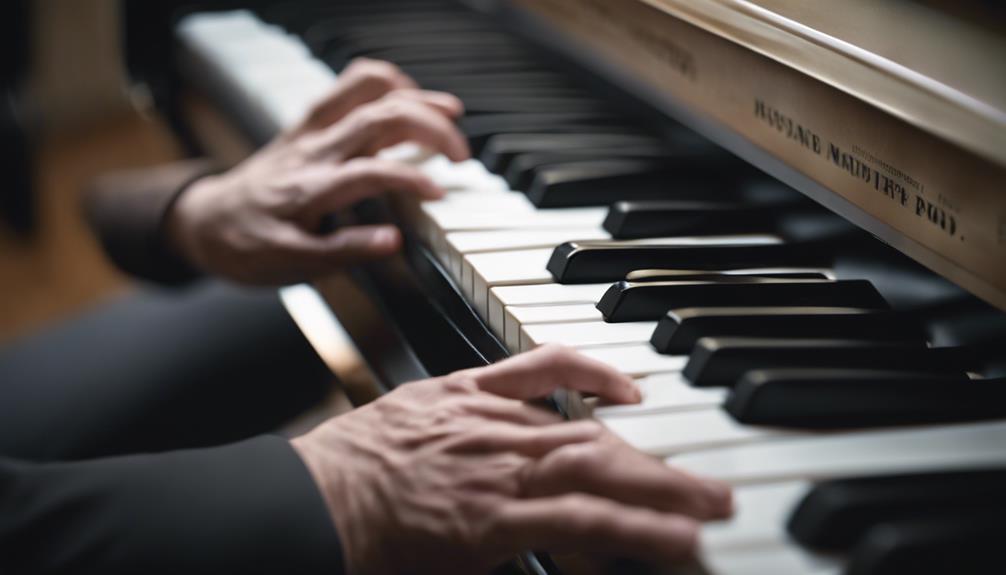
When you press the sustain pedal, located on the right side of the piano, it lifts the dampers from the strings, allowing notes to ring out longer.
This pedal is essential for creating a smooth, connected sound and adding richness to your playing.
Pedal Function and Purpose
The sustain pedal, often called the damper pedal, lets you lift the dampers from the strings, allowing notes to ring out longer and create a more connected sound. Positioned on the right side of the piano, this pedal is crucial for producing a seamless flow in your music.
When you press the sustain pedal, the dampers lift, enabling the strings to vibrate freely and sustain the sound even after you’ve released the keys. This is especially useful for enhancing the resonance and depth of your music, particularly in legato passages.
Here’s how the sustain pedal can transform your playing:
- Extended Resonance: Notes continue to ring, creating a fuller, richer sound that can fill a room.
- Smooth Connections: Allows for smooth, connected connections between notes, ensuring a legato feel.
- Added Depth: Enhances the overall depth and complexity of the music, making it more expressive.
Using the sustain pedal effectively can elevate your playing, giving your music a professional and polished sound.
Proper Pedal Technique
Mastering proper pedal technique with the sustain pedal is vital for achieving a clear and expressive sound in your piano playing. When you depress the sustain pedal, it lifts the dampers from the strings, allowing the notes to sustain and resonate.
To use the sustain pedal effectively, you need to connect legato notes smoothly, creating a seamless sound. However, it’s essential to release the sustain pedal at the appropriate time to avoid a muddy or blurred sound.
A significant aspect of proper pedal technique is learning how to use the half-pedalling technique. By pressing the sustain pedal partially, you can achieve a more nuanced sustain effect, giving you greater control over the sound.
Additionally, experiment with delayed pedal usage to enhance phrasing and musical expression. This technique involves pressing the pedal slightly after playing the notes, which can add depth and emotion to your performance.
Soft Pedal
When you use the soft pedal, you shift the hammers to strike fewer strings, producing a softer and mellower tone.
This pedal is perfect for creating a more intimate atmosphere, especially in romantic and impressionistic pieces.
Mastering its technique can help you add dynamic contrasts and emotional depth to your performance.
Purpose and Functionality
You’ll find the soft pedal, often labeled as una corda, shifts the piano mechanism to strike fewer strings, creating a softer and more muted sound. Located on the left side of the piano, the una corda pedal is a staple of acoustic pianos. When you use the soft pedal, you’re adding a layer of dynamic control to your performance. Depressing it allows you to produce a more delicate and subdued tone, enhancing the expressiveness of your music.
The soft pedal’s purpose and functionality can be boiled down to a few key points:
- Volume Reduction: By striking fewer strings, the soft pedal reduces the volume of the notes, making them quieter and gentler.
- Tone Alteration: It changes the quality of the sound, giving it a more muted and softer character.
- Dynamic Range Expansion: It provides you with greater control over dynamics, allowing for more nuanced and expressive playing.
Understanding and mastering the use of the soft pedal can notably elevate your musical interpretation. By incorporating it effectively, you can create a more varied and emotionally rich performance. This pedal isn’t just a tool; it’s a gateway to deeper musical expression.
Technique and Application
To effectively utilize the soft pedal, begin by gently pressing it with your left foot while maintaining a relaxed posture. The soft pedal, also known as the una corda pedal, shifts the piano’s mechanism so that the hammers strike fewer strings, resulting in a softer, more muted sound. This pedal is essential for achieving a quieter and less bright tone, which can significantly alter the tonal quality of your playing.
By engaging the soft pedal, you can explore a range of dynamics and add expressiveness to your music. The altered timbre created by the una corda pedal allows for nuanced interpretations, making your performance more engaging. Experiment with different pressure levels to discover how the soft pedal can change the character of each note.
Disengaging the soft pedal is equally important. Release it smoothly to return to the piano’s full, vibrant sound without disrupting the flow of your piece. Understanding how to properly engage and disengage the soft pedal enhances your control over dynamics and overall musical interpretation.
With practice, you’ll find that the soft pedal is an invaluable tool for adding subtlety and depth to your performances.
Sostenuto Pedal
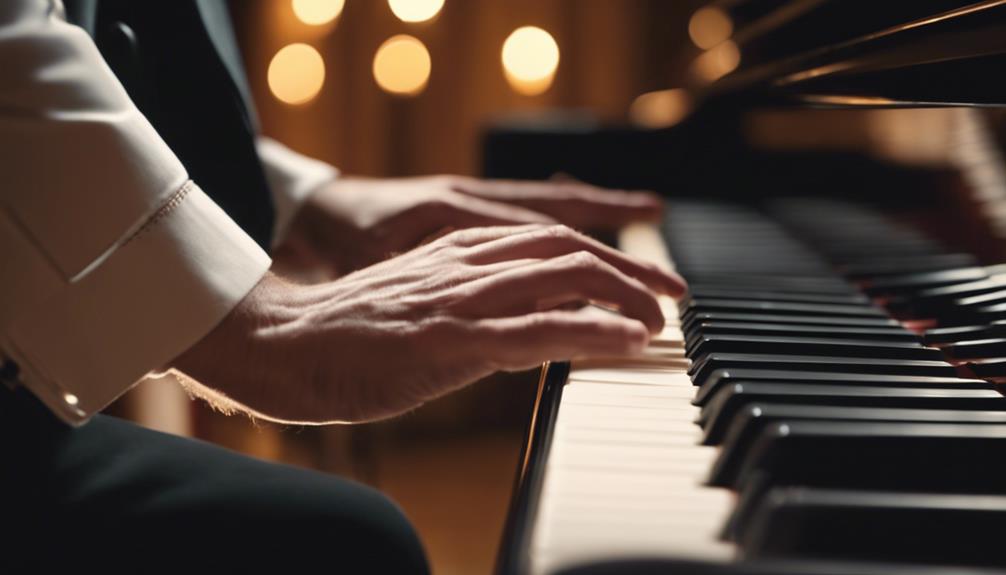
Ever pondered how the sostenuto pedal can create unique layers of sound on the piano? The sostenuto pedal, usually found as the middle pedal on a piano, has the fascinating ability to selectively sustain specific notes while allowing others to remain unaffected. This pedal is especially useful in contemporary compositions and avant-garde music, where composers often seek to create complex, layered soundscapes.
By pressing the sostenuto pedal, you can hold down certain notes and let them ring out, while playing additional notes that won’t be sustained.
Here are three key points to contemplate:
- Selective Sustain: Unlike the damper pedal, the sostenuto pedal sustains only the notes that are being held down at the moment the pedal is engaged, enabling intricate harmonic textures.
- Contemporary Compositions: Many 20th and 21st-century pieces use the sostenuto pedal to achieve modern and experimental sounds, making it a staple in avant-garde music.
- Alternative Functions: Be aware that some piano models might’ve different functions for the middle pedal, such as a bass sustain or practice pedal, so always check your piano’s specifications.
Understanding how to use the sostenuto pedal can greatly expand your expressive capabilities on the piano.
Digital Pedals
When using digital pedals, you’ll notice they come in various types, such as sustain, soft, and sostenuto, each enhancing your expressive capabilities.
Adjusting the pedal sensitivity can greatly improve your sound quality, making your performance more dynamic and tailored to your style.
With the flexibility and convenience of digital pedals, especially in compact setups, you can achieve a professional sound even in a portable environment.
Types of Digital Pedals
Digital pedals for pianos bring a range of features that mimic and expand on the traditional functions of acoustic piano pedals. When you’re using digital pianos, the pedals you use can make a significant difference in your playing experience. Typically, you’ll find three main types of pedals: the soft pedal, damper pedal, and sostenuto pedal. These pedals are designed to replicate the feel and function of their acoustic counterparts while offering additional benefits like customizable settings for pedal sensitivity and response.
Here’s a closer look at the types of digital pedals:
- Soft Pedal (Una Corda): This pedal lowers the volume and alters the timbre of the notes, giving you a softer, more delicate sound. It’s perfect for passages that require a gentler touch.
- Damper Pedal (Sustain Pedal): Probably the most used pedal, it allows notes to ring out longer by lifting the dampers off the strings. This enriches your sound and adds depth to your music.
- Sostenuto Pedal: This pedal sustains only the notes that are being held down when the pedal is pressed, allowing for more complex musical textures.
These digital pedals usually connect to the piano electronically, ensuring seamless integration and enhanced performance capabilities. Customizing pedal sensitivity and response further tailors the playing experience to your preferences.
Enhancing Sound Quality
Utilizing digital piano pedals can greatly enhance the sound quality of your music, offering a richer and more expressive playing experience. Digital pianos often come equipped with a sustain pedal that replicates the functionality of an acoustic piano’s sustain pedal. This pedal is essential for creating smooth, connected notes and sustaining chords, which adds depth to your music.
Additionally, some digital pianos include soft and sostenuto pedals. The soft pedal, often labeled as ‘una corda,’ reduces the volume and alters the timbre, providing a gentler sound. The sostenuto pedal, on the other hand, sustains only the notes that are being held down when the pedal is pressed, allowing for more nuanced musical passages.
One of the advantages of digital pedals is their adjustability. You can customize the sensitivity and responsiveness to match your playing style, ensuring a more authentic experience.
Digital pianos also offer virtual pedal effects, which allow you to experiment with different sound enhancements that aren’t possible on an acoustic piano.
Pedal Techniques
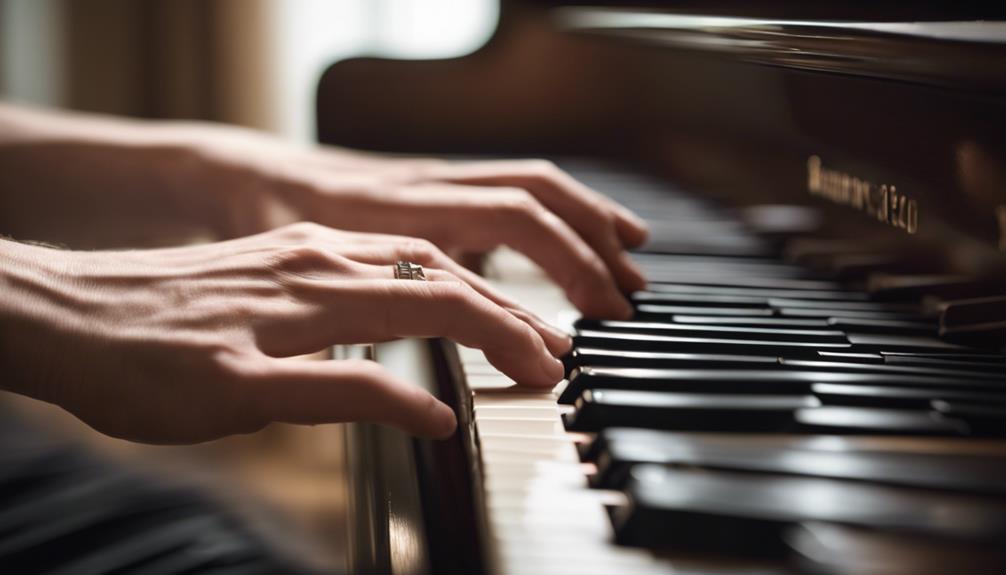
Mastering pedal techniques can greatly enhance the expressiveness and clarity of your piano playing. Using the sustain pedal with your right foot and the soft pedal with your left foot, you can create a wide range of sounds. It’s essential to understand and practice different pedal techniques to achieve the best results.
- Half Pedaling: This technique involves pressing the sustain pedal halfway down, allowing partial damping of the strings. It creates a more subtle sustain effect, useful for delicate passages.
- Simultaneous Pedaling: Engage the pedal simultaneously with the keys for a more connected sound, especially useful in legato passages.
- Preliminary Pedaling: Press the pedal just before or as you strike the keys to blend the sound more smoothly.
Avoid overusing the sustain pedal, as it can make your music sound muddy. Instead, focus on developing controlled movements with your feet. Smoothly lifting and pressing the pedal ensures seamless shifts between chords.
Practice resetting the pedal between chords to prevent dissonance and maintain a clean sound. These techniques require practice, but with dedication, you’ll achieve a polished and expressive performance.
Sustain Pedal Technique
Pressing the sustain pedal with your right foot lifts the dampers off the strings, allowing the notes to resonate longer. This technique, known as the sustain pedal technique, is vital for creating rich, resonant sounds.
When using the pedals, particularly the sustain pedal, you can achieve sympathetic vibrations, adding depth to your music.
For playing legato, try delayed or legato pedalling by pressing the pedal right after playing the notes. This smooths connections between chords, creating a seamless sound.
Conversely, for playing staccato, release the pedal quickly to create clear breaks in the sound.
Experiment with half-pedalling techniques by pressing the sustain pedal halfway. This provides a partial sustain effect, giving you more control over the resonance.
Remember, effective use of the sustain pedal can transform your performance, making it more expressive and dynamic.
While using the sostenuto and pedal una corda are also important, focus on mastering the sustain pedal first. It’s the foundation of your pedal technique.
Sostenuto Pedal Technique
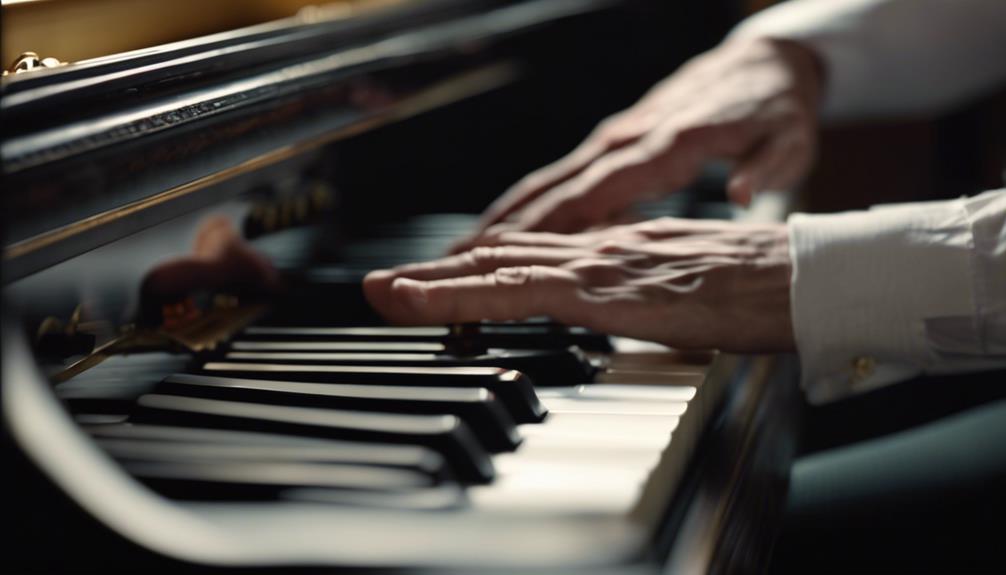
The sostenuto pedal, found in the middle of the piano’s pedal array, allows you to sustain specific notes while letting others remain unaffected. This pedal is often overlooked but offers unique sustain capabilities that can add depth to your playing. Especially popular among progressive composers, the sostenuto pedal lets you hold certain notes or chords without sustaining the entire soundscape.
Wondering when to use the sostenuto pedal? Here are three scenarios:
- Complex passages: Sustain specific bass notes to free up your hands for intricate melodies.
- Layered textures: Create a rich, layered sound by holding harmonic notes while playing a contrasting melody.
- Pedal shifts: Smoothly shift between different pedal effects without losing important sustained notes.
To master how to use the sostenuto pedal, follow these steps:
- Depress the notes you want to sustain.
- Press the sostenuto pedal while holding those notes.
- Release the keys and continue playing other notes unaffected by the sustain.
Soft Pedal Technique
While the sostenuto pedal offers unique sustain capabilities, the soft pedal brings a different dimension by muting and softening the piano’s tone. Also known as the una corda pedal, this pedal shifts the piano mechanism so that the hammers hit fewer strings per key press. As a result, you get a muted and softer tone compared to the piano’s regular sound.
To use the soft pedal, you’ll typically use your left foot. By pressing down on this pedal, you reduce the volume and alter the timbre of your notes, allowing for greater dynamic contrast in your playing. This technique is particularly useful when you want to add expressive nuances to your performance.
The una corda pedal isn’t just about making the piano quieter; it’s also about changing the character of the sound. When you engage this pedal, you create a more intimate and delicate atmosphere, perfect for sections of music that require a gentler touch.
Mastering the use of the soft pedal can enhance the emotional depth and variety in your playing, making it an essential tool for any serious pianist.
Common Mistakes
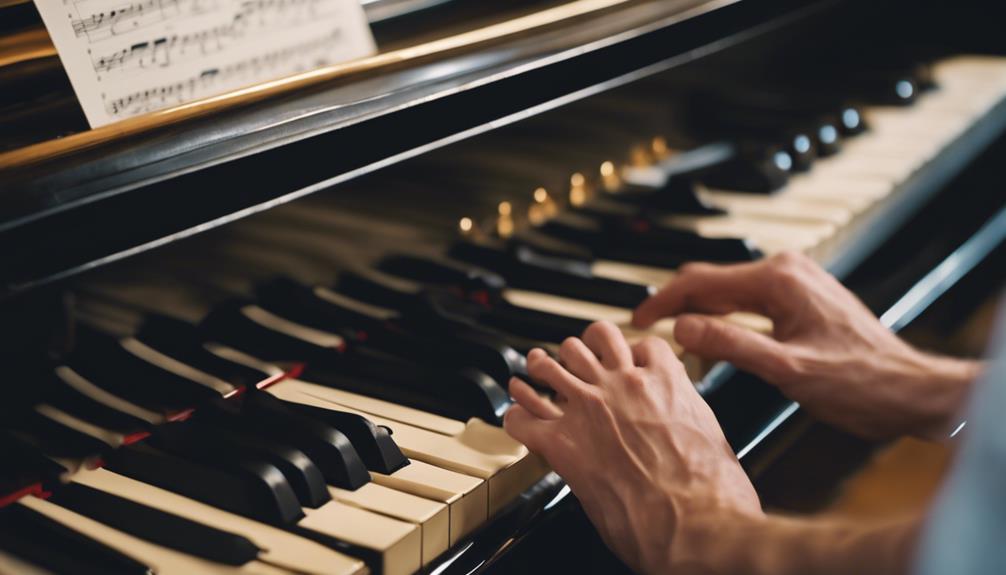
Many pianists struggle with common mistakes like over-pedaling, which can result in a muddy sound. When you hold down the pedal continuously, it causes the notes to blend together in an undesirable way. It’s important to avoid this by lifting the pedal more frequently.
Another common issue is late pedal release. If you release the pedal too late, the notes blur together, impacting the clarity of the music. To prevent this, practice releasing the pedal at the right moment to maintain the piece’s intended articulation.
Incorrect timing with pedal use can disrupt the flow and overall performance of your music. Developing precise control over your pedal technique is essential.
Here are three tips to improve your technique:
- Strategic Use: Use the pedal thoughtfully and sparingly to enhance, not overpower, the music.
- Proper Timing: Sync the pedal with your finger movements to ensure the notes sound clean and intentional.
- Attentive Listening: Always listen carefully to the sound you produce and make adjustments as needed.
Pedal Markings
When mastering pedal technique, understanding pedal markings in your sheet music is essential to achieving the desired sound and expression. Pedal markings tell you when to engage and release the sustain pedal, which can significantly impact the dynamics, phrasing, and overall sound quality of your piano performances.
In your sheet music, you’ll often see symbols like ‘Ped.’ to indicate when to press the sustain pedal and an asterisk (*) to signal when to lift it. These markings are vital for sustaining and stopping notes at the right moments.
Besides the sustain pedal, you might encounter markings for the soft pedal and the sostenuto pedal. The soft pedal, usually marked as ‘una corda’ or ‘U.C.,’ softens the sound, while the sostenuto pedal, often marked as ‘S.P.,’ holds specific notes while allowing others to play normally.
Accurately following these pedal markings is important for correct musical interpretation. They help convey the composer’s intentions, adding depth and emotion to your performance.
Next up, read our full guide on how to play the piano for beginners right here.
